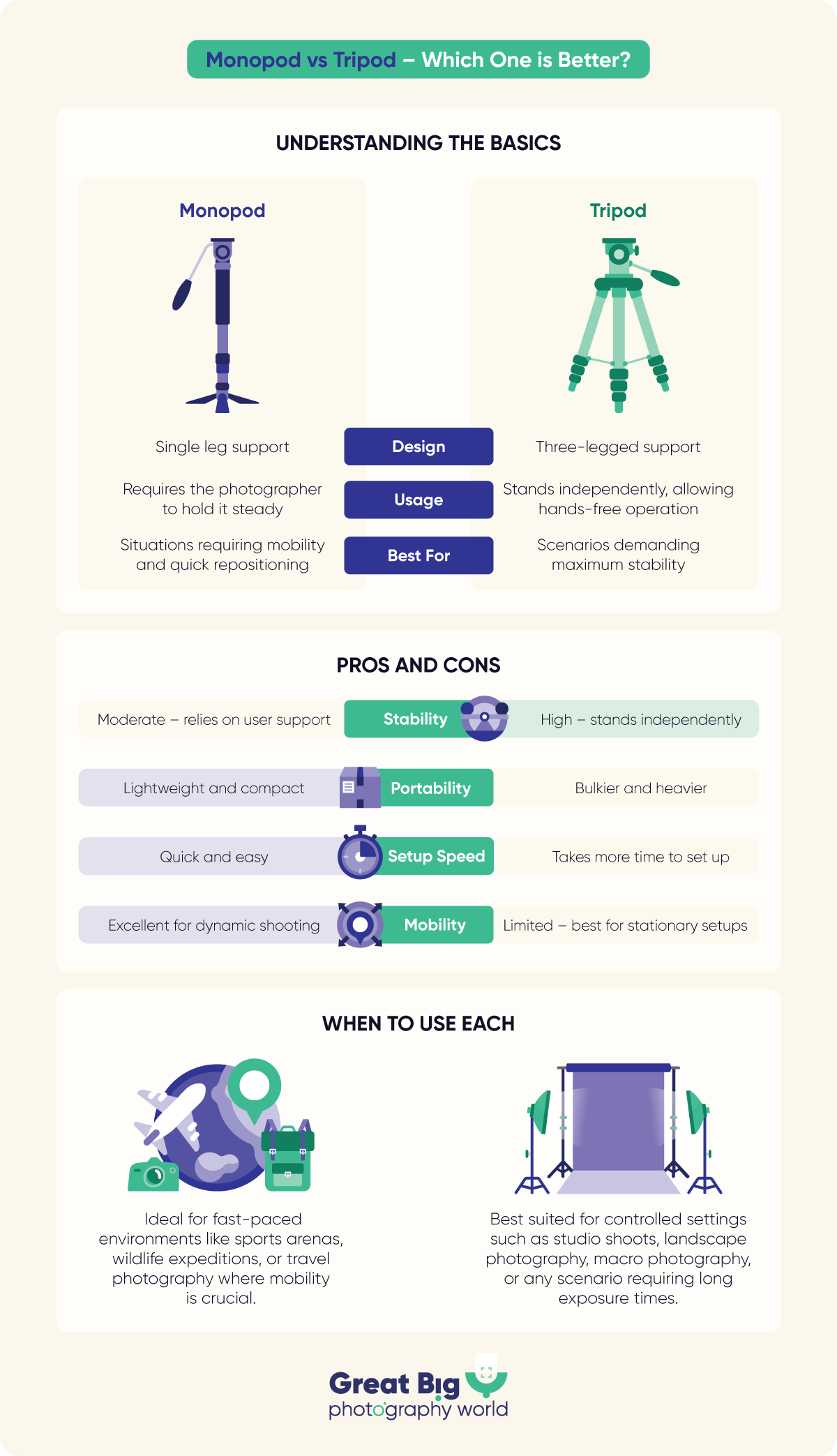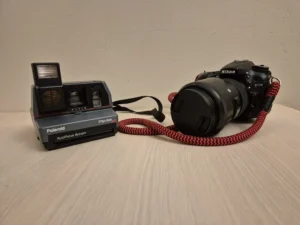Hand-holding your camera provides incredible control for the perfect shot; However, camera shake can become a nuisance at lower shutter speeds. In the common debate about image stabilization, the question of monopods vs tripods usually comes up.
Monopods and tripods enable you, as the photographer, to capture images in a way that you simply can’t do holding your camera in your hands.
But which one is better? Certainly, they both have their uses in different scenarios, but can you get away with using just one? Both have their purposes, and in some cases, you can use either, but let’s take a deeper dive into the strengths of these two essential photography tools.
Contents
What is the Difference Between Monopod and Tripod?
Monopods and tripods provide stable camera support when shooting in a fixed position. The main difference (and the only one) is the design of the legs. The “mono” in monopod means one leg, while the “tri” for the tripod alludes to it having three legs.
Monopods have only one leg that can extend to varying lengths. This makes it more of a support pole for your camera, kind of like a hiking pole or walking stick. With a single point of contact on the ground, a monopod will keep your camera steady.

You mount your camera on the tripod head located on top. The most popular type of tripod heads would be a ball head. A ball head allows your camera to move in a variety of directions and angles. Ball heads can be found on both monopods and tripods. The other type of tripod head would be a tilt head, and as it sounds, a camera mounted on one of these can only tip forward and backward.
A tripod is a three-legged device that provides the same support as a monopod. However, you don’t need to hold it while shooting. Most tripods generally have legs that extend, which enables the photographer to get a variety of angles for their shot.
Check out our comparison infographic below for the key differences, pros, cons, and best-use scenarios.

A lot of the remaining features and design aspects are relatively similar. You’ll often find manufacturers releasing both a monopod and a tripod version of a product. When searching for a reputable product, look for a tripod brand such as Manfrotto or Benro.
Though, for many photographers, the number of legs matter. It may be more difficult to get some shots using one or the other. Different scenarios require different equipment, so let’s take a look at how you could use each in different niches.

How to Choose Between Tripods Vs Monopods
Taking photos is more than just pointing your camera and shooting. Different niches require various lighting and camera settings. Tripods and monopods can be used in a variety of situations, but it’s important to learn how to discern which is better for what you’re shooting. You want to start by looking at what lens you’re using. A longer one, like a telephoto lens, will need a sturdy tripod to keep it standing, for example.
Long Exposure Photography
Long-exposure photography is a broad topic that ranges from nighttime photography to shooting long, silky exposures of waterways. The key to successful image stabilization with slow shutter speeds is to use a tripod to keep your camera still. Quite simply, it’s difficult to maintain stability for a long shutter speed with a monopod, making tripods the only option for long exposures.
For nighttime photography, you’ll find that you have a shutter speed of 30 or more seconds. This task is near impossible for the average photographer shooting handheld, and you’ll more than likely introduce camera shake into your images from the long exposures.
A tripod excels in this situation since holding a camera monopod for extended periods can still produce a fuzzy image. Having a tripod with a weight in the middle keeps the camera still if the shutter speed is very slow.

Macro Photography
Macro photography is all about bringing the small world to life in front of our eyes with a 1:1 ratio. The incredible detail needed for sharp images requires that your camera be held very still. If you have a heavy camera, then keeping it upright will prove difficult without the additional legs.
Since a lot of macro objects are closer to the ground, a popular technique for photographers is to invert their tripods so that the camera is actually upside down, getting the lens and camera closer to the subject. This process is impossible to do with a monopod without introducing any kind of blurring.
Landscape Photography
Both a tripod and a monopod work very well in a landscape photography setting. Landscape photographers are more than likely going to be stationary for several minutes (even hours!) as the light reaches the perfect angle.
A tripod will work best for sunrise and sunset photos as the light will be dim enough to cause some blurring, and the three-legged stable platform will eliminate that from happening. If you’re looking to capture a time-lapse, then having a tripod ensures that all of the photos are even and smooth.
However, since tripods have more weight to them, carrying them to the location can sometimes be a hassle. A folded tripod in your camera bag will always take up more room than the single detachable leg of a monopod.
A monopod is lighter, has fewer limbs, and can mimic a tripod if you put it into the ground at an angle and use your body as an anchor for it.
If you have other photographers around you, a monopod is less cumbersome and won’t be accidentally knocked by errant limbs. When the light shifts (and it will), moving a monopod is much easier than shifting tripod legs, especially if the ground isn’t level.
Wildlife Photography
Depending on the animal that you’re trying to photograph, a monopod might be the best choice for photographing wildlife. For example, wildlife photographers going after birds will soon realize that they can be very quick or stay in one spot for several minutes.
The unpredictability means you might have to move somewhere very fast, which can be difficult if you’re bringing a tripod with you. Monopods are often used with long lenses, the primary equipment of a wildlife photographer.
Sometimes, you have to go deep into the backcountry to catch an elusive animal, and the packability of a monopod’s small size means you can go further with less weight.
Wintertime photographers know the hindrance a tripod can bring as you more than likely have snow to deal with too. There are just too many nooks and crannies on a tripod where snow and ice build up.
If your subject is stationary, say, an Osprey nest where the birds are in one general location, a tripod will come in handy to help keep your arms from getting fatigued.

Wedding Photography
You can use a tripod or monopod for wedding photography, and both will help you produce incredible shots. The ceremony is one of the most important parts of the event, and sometimes the lighting is too dim to use the hand-holding alone. A monopod provides that extra bit of stability without the setup time so that you don’t miss your shots.
For bride and groom photos afterward, a tripod will be your main contender for needed gear. Typically, these photos are shot closer to sunset to capture the golden radiance of the sun dipping below the horizon. This makes for some beautiful photos but also incredibly low light that is always changing.
Setting up your tripod allows you to move the camera when you need to, but keep it stationary enough that you’re not wasting time as the light fades. Portrait photographers who photograph weddings will often use tripods for their sessions since their subjects are likely posing instead of moving.
Product Photography
Using a tripod is ideal for product photography as your subject is more than likely stationary, and you need to squeak every last ounce of detail out of your shot.
Generally, there isn’t much movement needed for product photos, so a tripod makes the most sense to use. You’re also shooting inside, much like studio photography, so you’re able to control every aspect of the environment in the frame.
That being said, using a monopod will work just fine for product shots, it’s just a tripod that makes the job easier.
Sports Photography
Sports photography is fast-paced, crowded, and full of distractions, so you need a way to stabilize your camera without taking up a whole mess of the room. A tripod can become a hazard to people around you as it has multiple legs that splay out. One trip can send the person (and your camera) falling to the ground. In terms of monopods vs tripods, monopods will take the lead here for many photographers.
A monopod works perfectly here because you can anchor the bottom on just about anything and get that much-needed stability for capturing detail in the movement without motion blur. This is why you’ll commonly see sports photographers resting on a monopod rather than setting up a tripod. You’ll also be using some pretty large lenses that will get tiring to hold after several minutes of tracking.

Can Monopods Replace Tripods?
As you can tell, in the battle of a monopod vs. tripod, there is no clear winner since they each have their strengths and weaknesses. However, there are clear reasons why you would use one over the other, which we can go over below.
Monopods
A monopod can be anything from a professional piece of gear to a hiking pole you use in the backcountry. For your camera’s sake, look for one that is sturdy and made with carbon fiber.
If you’re going to have an expensive piece of technology on top, shell out a few more bucks to make it last.
- Can pack up very small, great for extended photography trips
- Quick repositioning ability
- A light enough tripod can replace a monopod if it’s small enough
- Image stabilization in modern cameras can replace a monopod
Tripod
Tripods are traditionally used over monopods since they provide the ultimate stability for your shot. You really can’t beat three legs versus just one. You can find them being used in many niches, and the pricing can range anywhere from $50 to $1500 (USD).
Not all tripods are the same. You can choose aluminum or carbon fiber options but keep in mind that they can weigh a lot if you opt for a heavier construction.
- Provides the best stability option for cameras
- Tripods can be positioned in a variety of ways
- They can be bulky and heavy
- Setup is far slower than with a monopod
Hybrids
Having a hard time choosing when it comes to monopods vs. tripods? Some manufacturers produce a tripod monopod combination where the monopod has a miniature tripod at the bottom. This gives you the flexibility of using a monopod that has the stability of a tripod.

Final Thoughts
For most setups, photographers can use either a tripod or a monopod with the same results. In the battle of monopod vs tripod, some believe the sleek profile and quick changes they can make with a monopod, whereas others enjoy the stability of three legs.
Some photography shooting styles require one over the other, as can be found in the sports world, where photography gear needs to be packable and efficient. Figuring out what works best for you is determined by what you’re photographing and how to maximize your photographic workflow.









